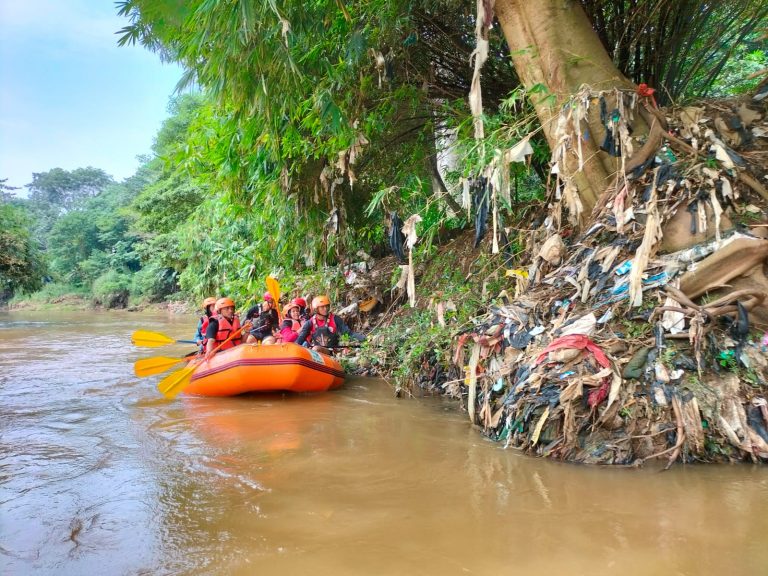What Can We Do to Save Our Rivers from Pollution?
Figure 1: https://ecoton.or.id/2023/01/03/press-release-sungai-indonesia-darurat-sampah-plastik-survei-ecoton-68-masyarakat-butuh-fasilitas-sampah-dan-akses-pengaduan/
Pollution in rivers is still a problem that cannot be resolved in Indonesia. Based on the results of the Nusantara River Expedition by ECOTON, several facts were found that 70.7% of rivers in Indonesia were still polluted by garbage pollution, 19.4% of the water showed signs of being polluted (foaming, discolored and smelly), and the remaining 3.5% is the mass death of fish occurring in the river. This shows how big the pollution of rivers in Indonesia is which results in a decrease in water quality and causes the death of living things in river waters. In fact, water is a natural resource that is needed by humans. In addition, the Executive Director of ECOTON, Prigi Arisandi stated that around 84% of the raw materials for drinking water consumed by the community, especially in the Java region, the water sources come from rivers. This fact is also increasingly concerning, especially because around 70-80% of rivers in Indonesia are polluted by various household and industrial wastes without any further treatment by the government. If this pollution continues, river ecosystems in Indonesia will experience fatal damage that will have a negative impact on human life. For this reason, it is necessary to take steps to restore the river so that it can function properly and not interfere with human activities.
According to Cleanipedia, there are several ways to tackle the problem of river pollution in Indonesia. First, build a wastewater treatment plant (WWTP) that can treat hazardous industrial waste before it is discharged into the river. The IPAL system consists of 3 processing stages, namely Primary Treatment, Secondary Treatment, and Tertiary Treatment. Primary Treatment is the process of separating solids and liquids using filters and sedimentation tanks. Secondary Treatment is a coagulation process that aims to remove colloids and stabilize organic matter in waste. Tertiary Treatment is the removal of nutrients and the addition of chlorine to eradicate disease-causing microorganisms. Second, managing domestic waste such as excrement so that it does not directly contaminate water. This can be done by using an adequate disposal system and complying with regulations on the minimum distance between the household sanitation system and water sources. Third, educating the public about the dangers of river water pollution and giving directions so they don’t litter. Fourth, support the use of eco-friendly products that are safe for the environment, especially products that can help minimize water pollution. For example, the use of environmentally friendly detergents, organic fertilizers and pesticides, packaging made from recycled plastic which is more easily decomposed. Fifth, carry out reforestation and programs that support the continuity of clean water sources.
River pollution in Indonesia is a serious problem that needs to be addressed immediately. The high percentage of rivers polluted by garbage, changes in the color and smell of the water, and the mass death of fish show how serious this problem is. If the pollution continues, there will be damage to the river ecosystem which will have a negative impact on human life. For this reason, there is a need for river restoration measures and better waste management. Several steps that can be taken to tackle river pollution in Indonesia are building a wastewater treatment plant (WWTP) to manage industrial waste, managing domestic waste such as feces with an adequate disposal system, educating the public about the dangers of river water pollution, supporting the use of environmentally friendly products, and carry out reforestation as well as programs that support the sustainability of clean water sources. By implementing these steps, it is hoped that the problem of river pollution in Indonesia can be reduced and the sustainability of river ecosystems and the availability of clean water can be maintained.
References:
- Basyaiban, M. K. (2023, January 3). Press release: Sungai Indonesia darurat sampah plastik. Survei ECOTON: 68% masyrakat butuh fasilitas sampah dan akses pengaduan. ECOTON. https://ecoton.or.id/2023/01/03/press-release-sungai-indonesia-darurat-sampah-plastik-survei-ecoton-68-masyarakat-butuh-fasilitas-sampah-dan-akses-pengaduan/
- Cleanipedia. (2023, July 5). 8 Cara Mengatasi Pencemaran Air. https://www.cleanipedia.com/id/cara-mengatasi-pencemaran-air.html
- Riski, P. (2022, March 3). Banyak Sungai Tercemar, Ecoton Lakukan Ekspedisi Sungai Indonesia. VOA Indonesia. https://www.voaindonesia.com/a/banyak-sungai-tercemar-ecoton-lakukan-ekspedisi-sungai-indonesia/6468315.html


